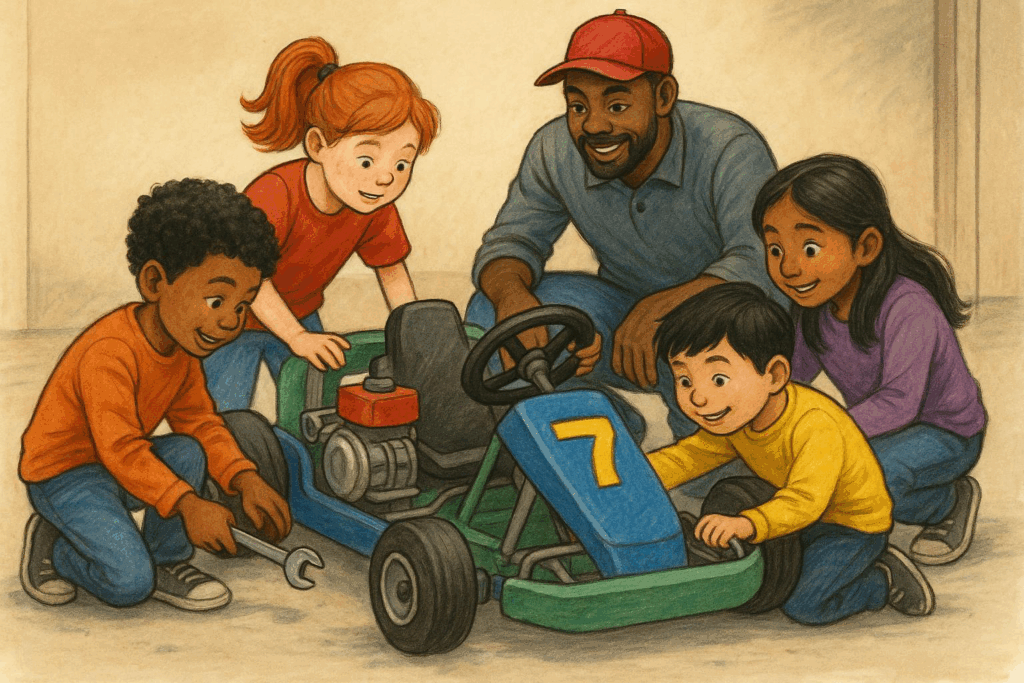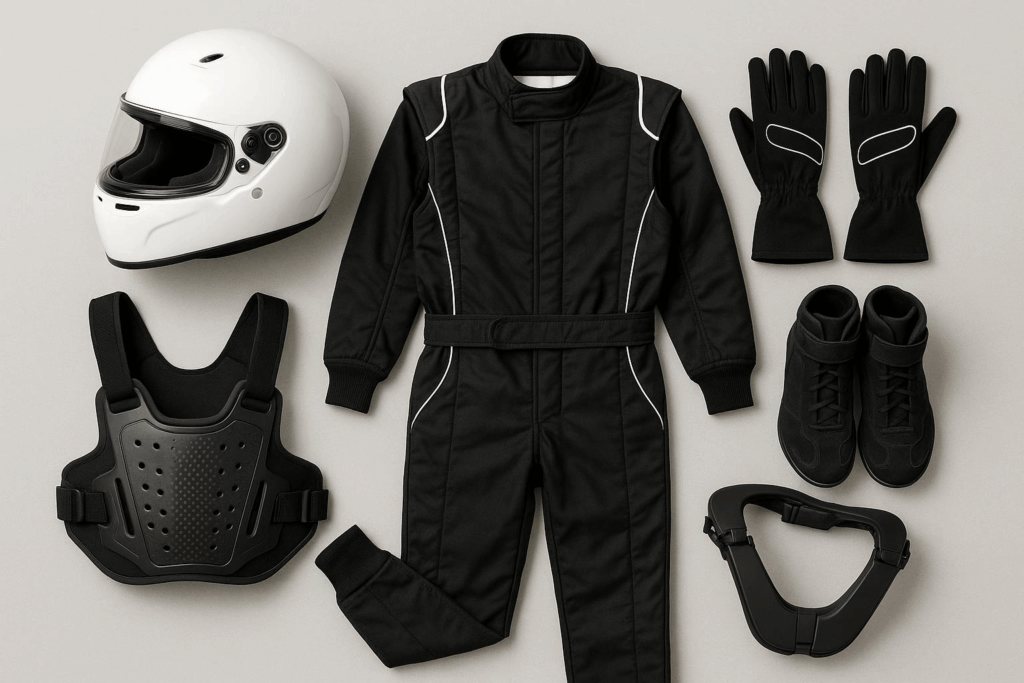
Motorsports often make people think of fast cars, loud engines, and some excitement mixed with a bit of risk. Even though Formula 1 sounds far away from everyday life, helping your kids get into motorsports is easier and safer than you might think.
It isn’t just about trying to win races; motorsports offer great adventures that teach important life skills, boost confidence, and create memories.
Treat it like an action-packed playground where your child can learn valuable lessons. Just like any sport, the right gear is a must.
Whether your child dreams of being the next Max Verstappen, or looks up to a new favorite whose Oscar Piastri merchandise is flying off shelves, making sure they have the right equipment is the very first step to keeping them safe while they chase their dream.
At every twist and turn, safety should always come first. The right equipment isn’t just recommended – it’s an absolute requirement to keep your child’s motorsport experience fun and secure. Everything from helmets that protect their head to suits that shield them from track accidents plays a part in their safety.
Why Let Your Kids Try Motorsports?
Motorsports give kids a mix of physical fun, mental challenges, and chances to meet new people. It’s about much more than just driving fast; it’s a way for kids to learn and grow while having exciting fun.
Motorsports Help with Confidence and Self-Control
Getting into a kart or a junior race car can be scary at first. As your child learns to control the vehicle, steer around the track, and figure out what to do during different situations, they start to believe in themselves more. They have to follow instructions, listen to coaches, practice regularly, and keep their gear in good condition. This helps them learn responsibility and respect for rules, which are important both on and off the track.
Kids Develop Coordination and Learn Technical Skills
Driving even a child-sized racing vehicle takes good coordination, quick thinking, and clear awareness of what’s going on around them. As they drive, kids react quickly to what’s happening and make fast decisions. They also learn about how their car works and may even help fix basic issues, gaining hands-on technical skills that help them as they grow older.
Learning Fair Competition and Teamwork
Racing is competitive, but it also encourages friendship and good sportsmanship. Kids learn to be fair, handle wins and losses, and respect other drivers. Some types of motorsports involve teamwork, whether they’re working with a coach, mechanic, or friends from their club. This teaches how to cooperate, talk things out, and support each other.
Bonding Time for Families
Motorsport can be something the whole family does together. Parents and kids might work together on the vehicle, travel to events, or celebrate victories and learn from losses. These shared experiences help families bond and create special memories that go well beyond racing.

How to Start Your Child in Motorsports
There are many kinds of motorsports, and the right starting place for your child depends on their age, size, maturity, and your family’s interest and budget. There isn’t just one way to get started.
How to Choose the Right Kind of Motorsports for Your Child’s Age
The minimum age to start depends on the activity and the rules at your local track or club. In the United States, kids as young as 3 or 4 can try Kid Kart racing, which uses small engines and is focused on learning basic skills. By age 5 or 6, they might enter beginner classes like Outlaw Karts, which are small cars with safety cages.
As kids get older, they move into higher classes. From about 7-12, they may join Cadet karting or Junior Sprints, which have bigger engines and faster speeds. The Junior karting class is usually for children aged 12-15 and involves even more powerful karts.
Once they turn 14 or 15, they can enter senior karting or even faster shifter karts. You should always check the specific requirements for the class and track you’re interested in, since rules can change.
Comparing the Most Popular Types of Youth Motorsports
Karting is the most common way to start, with different classes and types such as Sprint (for smaller tracks) and Road (for larger tracks). Karts can be made for different types of tracks and have engines ranging from simple low-horsepower to high-performance types.
Other common youth motorsport choices are:
- Outlaw Karts: Small sprint cars for oval and dirt tracks, with plug-and-play beginner classes.
- Junior Sprints: For ages 6-12, these cars are smaller versions of sprint cars.
- Quarter Midgets: For ages 5-16, these tiny race cars have several classes and engine sizes, and are very popular.
- Junior Drag Racing: For ages 5-17, using scaled-down drag racing cars.
- Bandolero Racing: For kids as young as 8, these are small stock cars with limited horsepower.
- Legends Racing: Larger cars for older kids and teens, with more powerful engines.
Motocross, which uses bikes instead of cars or karts, is another option. What’s around you depends on your local clubs, so check with them to see what’s offered nearby.
How to Find Local Motorsports Clubs and Training Options
Start by finding a club or track near you. Search online for “youth karting” or “junior drag racing” with your location, or visit local tracks in person. Many clubs run beginner days where kids can try racing for the first time. These are often safe, supervised, and provide all the equipment you need.
Ask staff and other parents for help – the racing community is usually welcoming. Some families even practice first in empty parking lots using cones, just to get used to the controls before going to an active track.
What Gear Do Kids Need for Motorsports?
Once you’ve picked a sport, the next step is buying the right equipment. Remember, safety gear protects your child, so it’s never optional. Always check the rules for the class and track your child will be racing in.
Basic Safety Equipment Needed
Most youth forms of motorsports need the following gear:
- Helmet
- Suit (fire- or abrasion-resistant)
- Gloves
- Shoes (racing-specific for best safety)
- Rib Protector
- Neck Brace or Head & Neck Restraint
- Harness or Safety Belts (part of the vehicle but proper use is important)
- Chest Protector (mandatory in many junior classes)
- Fire-resistant underwear (if fire risk is present)
Helmet: The Most Important Gear
Helmets are the number one safety item and must be motorsport-approved, offering full-face protection. Don’t use bike or regular motorcycle helmets – they don’t meet the same standards and may break during a crash.
Look for models with certifications like Snell or DOT, as required. Helmets need to be the right size for children, as adult sizes can be too heavy and unbalanced for their heads and necks.
Racing Suits and Their Important Features
A racing suit protects your child if they fall or slide and, in some classes, must stop flames and heat as well. Suits should fit well – not too loose or too tight – and be flexible enough for kids to move easily. Entry-level classes sometimes allow cheaper, single-layer suits, but as your child moves up, you’ll need one made of better, fire-resistant materials.
Gloves: For Grip and Extra Protection
Racing gloves protect hands from burns and blisters and help your child hold onto the wheel. Gloves should be fire-resistant and not too tight or loose. The right size improves comfort and driver control.
Racing Shoes: For Safety and Control
Proper shoes make it easier to control the pedals and keep feet safe during accidents. Look for fire-resistant shoes with thin, grippy soles. For entry-level karting, some use sneakers or wrestling shoes, but racing shoes are much safer and should be used as soon as possible.

Rib Protectors and Chest Guards
Rib protectors are strongly advised for all kart drivers and are required in most junior classes. They keep the rib area safe from hard hits during sharp turns and help prevent serious injuries. Chest guards are often needed too and protect the middle part of the body.
Neck Braces: Protection From Serious Injuries
Neck braces or head and neck supports keep your child’s head steady in a sudden impact, helping to prevent whiplash or neck damage. These must be the right size for kids, since adult versions won’t protect them properly. Make sure they fit well but don’t block movement or vision.
Harnesses and Restraint Belts
Kids are kept safe in their seats by harnesses, usually included in the car. These are stronger than regular seatbelts and help during sudden stops or crashes. Always check after installation that these belts fit your child and work with the rest of their gear.
Extra Safety Gear
Depending on the class, you might also need flame-resistant underwear and arm restraints for open vehicles, which keep arms inside the car during a crash. Always double-check what’s required for your child’s group.
How to Get the Right Size for Motorsport Gear
Even if you buy the best equipment, it won’t protect your child unless it fits properly. Gear that is too big or small can be uncomfortable and dangerous.
Measuring for Helmets and Suits
For helmets, use a soft tape measure around the widest part of your child’s head, about an inch above their eyebrows. Check the helmet maker’s size chart to pick the right one. It should be tight enough to not move but not so tight it hurts.
For suits, measure your child’s height, chest, waist, and inseam, then use the sizing chart from the manufacturer. The suit should move with your child but not fall off or bunch.
Measure their feet for shoes, counting the possible extra room taken by thick socks. Gloves need snug fit, so measure the hand’s width around the knuckles. Chest and neck size help pick the right fit for rib and neck protectors.
Why the Right Fit Matters for Safety and Comfort
Good fit means better protection and less distraction. A snug helmet spreads force around the whole head. A well-fitting suit prevents burns and scrapes. Comfortable gloves and shoes help with steering and pedal control. Gear made just for kids works better and is lighter, so it won’t wear your child out as fast.
How to Handle Growing Kids
Kids grow quickly, so most gear will need to be replaced with larger sizes over time. Some items, like rib protectors, can be adjusted a bit, but helmets, suits, shoes, and gloves need to be changed as your child gets bigger.
Trying to squeeze into small gear is unsafe and uncomfortable. Used, good-quality suits and gear can save money for non-core items. For helmets and neck supports, stick with new equipment for the best protection.
Looking After and Replacing Motorsport Gear
Racing equipment gets worn out with use. Keeping it clean and knowing when to replace it is important for your child’s safety.
When to Replace Gear
If a helmet is hit hard, even if it doesn’t break, it should be replaced right away. Helmet makers also recommend changing them every 3-5 years, as materials break down. Other gear (suit, gloves, shoes) should be checked for holes, worn spots, or weak stitching and replaced as needed. Harnesses and belts have expiry dates – always follow those rules.
Cleaning and Storing Gear the Right Way
Clean your child’s suit, gloves, and shoes as recommended by the brand, using the right detergents. Usually, helmets have washable liners that you can take out and clean. Dry everything fully before putting it away, and store items in a cool, dry spot away from sunlight and chemicals that could damage materials.
Mistakes to Avoid with Kids’ Racing Gear
Common safety mistakes include using adult gear that’s too big, or using helmets and equipment not meant for motorsports. Failing to update or replace damaged gear is risky too. Don’t skip cleaning or storing items properly. Always check your club or series rulebook to make sure you have everything you need, and talk to experts if you aren’t sure what to buy.
Ways to Keep Kids Safe in Motorsports
Wearing the right gear is only part of staying safe. Kids also need to learn safe habits and get good supervision.
Why Safety Training Matters
While equipment protects kids in an accident, learning how to avoid accidents is even better. Kids should practice driving safely, understand track rules, and learn to watch out for others. Training helps them stay safe every time they get on the track.
Building Good Skills for Everyday Racing
Safe habits go further than just wearing a helmet. Teach your kids to check their vehicles before every use, pay attention to rules, and concentrate while driving. Talk about what goes wrong and how to improve after each race or practice, and make learning the focus, not just winning.
The Parent’s Role at the Track
Parents should always check that their child’s gear is on properly and make sure their vehicle is safe. Know what to do in emergencies and get familiar with the safety crew at your track. Encourage your child, focus on having fun, and remember that your attention keeps them safer, even when track staff is present.
Where to Get Good Kids’ Motorsport Gear and Advice
Buying gear can feel like a big job, but the right store or website makes it easier.
Choosing Safe Brand Names for Children’s Gear
Buy important safety equipment, like helmets, from well-known companies known for their safety testing and quality. It’s better to spend a little more to keep your child safe. Safety gear might be expensive, but it’s worth it, and you can look for sponsorships to help pay for it. For less important items, buying used from trusted sources can be an option at lower levels.
Where to Buy Motorsport Gear
Some local tracks and clubs have shops or can recommend where to buy gear – ask for help with sizing. Online motorsport stores usually have wide selections and competitive prices but double-check size charts and return rules. Used gear can work for things like suits at lower levels where safety requirements allow.
How to Start Training and Racing
Many local clubs and tracks offer beginner lessons or “arrive and drive” days for first-timers. There are also videos, websites, and forums with tips on driving, safety, and how to care for karts. Start off practicing in a safe space with supervision before entering real races. Clubs help connect you with experienced families who can answer questions and offer support.
Common Questions About Kids in Motorsports
Parents usually have many questions – here are some quick answers:
What’s the Youngest Age Kids Can Start?
This depends on the event and class. In some karting types, kids start as young as 3 or 4; other classes start around age 5 or 6. Always check the track or club rules, and choose the class that fits your child’s size and maturity.
How to Find the Right Size Helmet for a Child?
Wrap a soft measuring tape around your child’s head, an inch above the eyebrows. Use this measurement and check with the helmet brand’s chart to pick the proper size.
Do Kids Need Rib Protectors?
Yes. Rib protectors should always be used in karting and are often required by the rules. They keep your child’s body safe from serious, painful injuries.
When Should Gear Be Changed?
Change helmets after any hit or every 3-5 years, whichever comes first. If any gear is torn, worn out, or doesn’t fit anymore, replace it. Always keep an eye on the expiry dates of belts and harnesses.
Helping Your Family Enjoy Safe Motorsports Together
Getting your kids involved in motorsports is about much more than racing. It’s about building confidence, sharing new experiences, and teaching valuable lessons. While the early costs of equipment and time may seem high, the rewards in skill, confidence, and family fun are worth it.
Motorsports teach kids things they might not learn elsewhere – like how to find sponsors, work as a team, stay organized, and solve real problems. The friendships and connections built at the track can last a lifetime, both for kids and parents. So, choose safe gear, find the right place to start, and get ready for lots of learning, fun, and the special sound of engines at your family’s next big adventure.


